A) -1.0, and X and Y are complements.
B) -1.0, and X and Y are substitutes.
C) 1.0, and X and Y are complements.
D) 1.0, and X and Y are substitutes.
F) A) and D)
Correct Answer

verified
Correct Answer
verified
Multiple Choice
At price of $1.20, a local pencil manufacturer is willing to supply 150 boxes per day. At a price of $1.40, the manufacturer is willing to supply 170 boxes per day. Using the midpoint method, the price elasticity of supply is about
A) 2.0.
B) 1.23.
C) 1.00.
D) 0.81.
F) C) and D)
Correct Answer

verified
Correct Answer
verified
Multiple Choice
When consumers face rising gasoline prices, they typically
A) reduce their quantity demanded more in the long run than in the short run.
B) reduce their quantity demanded more in the short run than in the long run.
C) do not reduce their quantity demanded in the short run or the long run.
D) increase their quantity demanded in the short run but reduce their quantity demanded in the long run.
F) None of the above
Correct Answer

verified
Correct Answer
verified
Short Answer
Figure 5-21 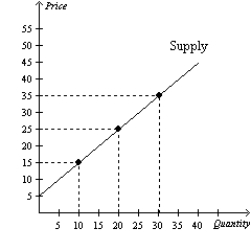 -If a supply curve is perfectly horizontal, what is the value of the price elasticity of supply?
-If a supply curve is perfectly horizontal, what is the value of the price elasticity of supply?
Correct Answer

verified
Correct Answer
verified
Multiple Choice
Figure 5-16 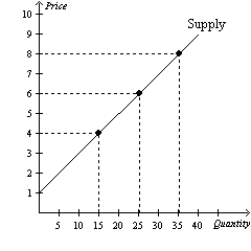 -Refer to Figure 5-16. Using the midpoint method, what is the price elasticity of supply between $4 and $6?
-Refer to Figure 5-16. Using the midpoint method, what is the price elasticity of supply between $4 and $6?
A) 0.75
B) 1.00
C) 1.20
D) 1.25
F) A) and C)
Correct Answer

verified
Correct Answer
verified
Multiple Choice
Figure 5-9 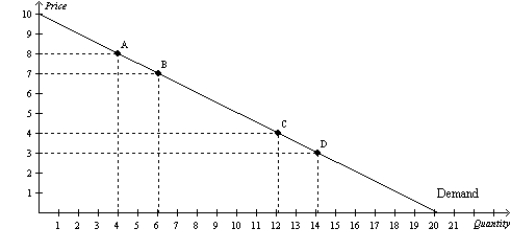 -Refer to Figure 5-9. If the price rises from point D to point C, total revenue
-Refer to Figure 5-9. If the price rises from point D to point C, total revenue
A) increases, and demand is price elastic.
B) decreases, and demand is price elastic.
C) increases, and demand is price inelastic.
D) decreases, and demand is price inelastid.
F) All of the above
Correct Answer

verified
Correct Answer
verified
Multiple Choice
If the price elasticity of demand for a good is 0.8, then a 12 percent increase in the quantity demanded must be the result of
A) a 0.06 percent decrease in the price.
B) a 1.5 percent decrease in the price.
C) a 9.6 percent decrease in the price.
D) a 15 percent decrease in the price.
F) A) and C)
Correct Answer

verified
Correct Answer
verified
Multiple Choice
Danita rescues dogs from her local animal shelter. When Danita's income rises by 7 percent, her quantity demanded of dog biscuits increases by 12 percent. For Danita, the income elasticity of demand for dog biscuits is
A) negative, and dog biscuits are a normal good.
B) negative, and dog biscuits are an inferior good.
C) positive, and dog biscuits are an inferior good.
D) positive, and dog biscuits are a normal good.
F) None of the above
Correct Answer

verified
Correct Answer
verified
Multiple Choice
If a 20% change in price results in a 15% change in quantity supplied, then the price elasticity of supply is about
A) 1.33, and supply is elastic.
B) 1.33, and supply is inelastic.
C) 0.75, and supply is elastic.
D) 0.75, and supply is inelastid.
F) A) and B)
Correct Answer

verified
Correct Answer
verified
True/False
Cross-price elasticity is used to determine whether goods are inferior or normal goods.
B) False
Correct Answer

verified
Correct Answer
verified
Multiple Choice
The price elasticity of supply measures how responsive
A) equilibrium price is to equilibrium quantity.
B) sellers are to a change in buyers' income.
C) sellers are to a change in price.
D) consumers are to the number of substitutes.
F) A) and D)
Correct Answer

verified
Correct Answer
verified
Multiple Choice
Table 5-7
The following table shows a portion of the demand schedule for a particular good at various levels of income.
 -Refer to Table 5-7. Using the midpoint method, when income equals $5,000, what is the price elasticity of demand between $8 and $12?
-Refer to Table 5-7. Using the midpoint method, when income equals $5,000, what is the price elasticity of demand between $8 and $12?
A) 0.56
B) 0.75
C) 1.33
D) 1.80
F) All of the above
Correct Answer

verified
Correct Answer
verified
Multiple Choice
If a 40% change in price results in a 25% change in quantity supplied, then the price elasticity of supply is about
A) 0.63, and supply is elastic.
B) 0.63, and supply is inelastic.
C) 1.60, and supply is elastic.
D) 1.60, and supply is inelastid.
F) A) and B)
Correct Answer

verified
Correct Answer
verified
Multiple Choice
How does total revenue change as one moves downward and to the right along a linear demand curve?
A) It always increases.
B) It always decreases.
C) It first increases, then decreases.
D) It is unaffected by a movement along the demand curve.
F) All of the above
Correct Answer

verified
Correct Answer
verified
Multiple Choice
Scenario 5-5 Milk has an inelastic demand, and beef has an elastic demand. Suppose that a mysterious increase in bovine infertility decreases both the population of dairy cows and the population of beef cattle by 50 percent. -Refer to Scenario 5-5. The equilibrium quantity will
A) increase in both the milk and beef markets.
B) increase in the milk market and decrease in the beef market.
C) decrease in the milk market and increase in the beef market.
D) decrease in both the milk and beef markets.
F) A) and C)
Correct Answer

verified
Correct Answer
verified
True/False
Price elasticity of demand along a linear, downward-sloping demand curve decreases as price falls.
B) False
Correct Answer

verified
Correct Answer
verified
Multiple Choice
OPEC successfully raised the world price of oil in the 1970s and early 1980s, primarily due to
A) an inelastic demand for oil and a reduction in the amount of oil supplied.
B) a reduction in the amount of oil supplied and a world-wide oil embargo.
C) a world-wide oil embargo and an elastic demand for oil.
D) a reduction in the amount of oil supplied and an elastic demand for oil.
F) A) and B)
Correct Answer

verified
Correct Answer
verified
Multiple Choice
Figure 5-4 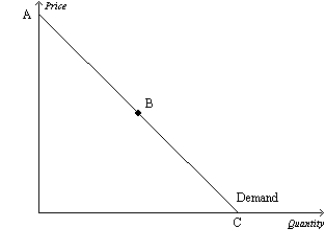 -Refer to Figure 5-4. If the price decreases in the region of the demand curve between points B and C, we can expect total revenue to
-Refer to Figure 5-4. If the price decreases in the region of the demand curve between points B and C, we can expect total revenue to
A) increase.
B) stay the same.
C) decrease.
D) first increase, then decrease until total revenue is maximized.
F) All of the above
Correct Answer

verified
Correct Answer
verified
Multiple Choice
Good news for farming can be bad news for farmers because the
A) supply curve for an individual farmer is usually perfectly elastic.
B) supply curve for an individual farmer is usually perfectly inelastic.
C) demand for basic foodstuffs is usually inelastic, meaning that factors that shift supply to the right decrease total revenues to sellers.
D) demand for basic foodstuffs is usually elastic, meaning that factors that shift supply to the right increase total revenues to sellers.
F) A) and B)
Correct Answer

verified
Correct Answer
verified
Multiple Choice
Figure 5-12 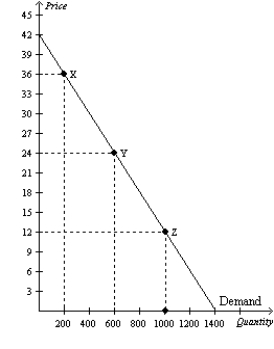 -Refer to Figure 5-12. Sellers' total revenue would increase if the price
-Refer to Figure 5-12. Sellers' total revenue would increase if the price
A) increased from $12 to $15.
B) decreased from $39 to $36.
C) decreased from $27 to $24.
D) All of the above are correct.
F) A) and B)
Correct Answer

verified
Correct Answer
verified
Showing 501 - 520 of 595
Related Exams